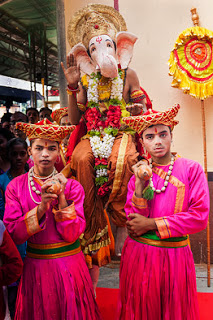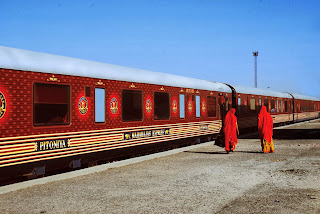 |
| Palace on Wheels Train |
Rajasthan, India — Trains are fascinating. If you have time and patience, train travel is one of the most enjoyable modes of transportation.
On my current tour of India, I traveled through the western Indian state of Rajasthan aboard the Palace on Wheels. It is a luxury tourist train that makes a weeklong excursion through the state.
From the moment I stepped onto the platform at the Safdar Jang railway station in New Delhi to the strains of live Indian music to the time I got off a week later at the same station, I had a journey of delightful sights, sounds, and smells.
The train is a vivid reminder of a bygone era when Indian rulers rode elephants to board their train compartments and travel in the lap of luxury and comfort. They almost literally carried their palaces with them — hence the name of the train.
A train journey such as this one amounts to much more than luxurious staterooms and a well-trained bevy of elegant-looking staff who look after your every whim.
Rajasthan is the most western state in India, adjoining Pakistan. It has a rich history. The Palace on Wheels provides its riders with glimpses of that history, with a backdrop of impressive palaces and forts.
The train stops at Jaipur, in the northern part of the state. Along the way, the train makes daylong stops in the cities of Udaipur, Chittorgarh, Jaisalmer, Jodhpur, and Agra, the site of the Taj Mahal.
With imagination, you could still hear the drumbeats of battles that were fought on the plains and hills of Rajasthan an eon ago. Tales of valor and bravery, mixed with a tinge of prejudice, are commonplace.
Each city has a compelling story of epic battles fought centuries and sometimes millennia ago. Some of those stories are part of local myth. One enduring myth is that religion always separated invaders from the invaded.
Chittorgarh, a fortress city on top of a broad hill, was coveted by many invaders because of its strategic location at the crossroads of southern Rajasthan and south Asia.
According to legend, the fortress repelled two attacks by the armies of kings from northern India. But in the third attack, in the 16th century, Muslim Mughal King Akbar, who ruled vast parts of India, conquered Chittorgarh.
Before the battle lines for the third attack were drawn, thousands of women in the besieged fort committed suicide. The legend of these Rajput women killing themselves to preserve their honor and that of their nation has become ingrained in the psyche of the people of Chittorgarh and other places.
A historic narrative defined by sharp religious borders ignores the fact that political alliances often crossed religious divisions. King Akbar’s trusted general, who led many a campaign, was Man Singh, the Rajput ruler of Jaipur.
The architecture of some cities of Rajasthan is breathtaking. Forts and palaces were built at strategic locations, with an eye for the environment and availability of local materials. Because of the colors of the stones that were used, Jaipur is called the Pink City and Jaisalmer the Golden City.
I was surprised to see a young man at every stop we made. A bag slung on his shoulder, he would greet passengers with clasped hands and a beautiful smile. He asked whether we needed a shoeshine.
He had been following this train for more than eight years, eking out a living by providing his services to well-to-do travelers. Even if your shoes do not need a shine, you feel compelled to help this cheerful and hard-working young man.
The unfolding panorama you see from the train is interesting and at times poignant. Urban areas — congested, chaotic, and deliciously eclectic — are a far cry from the laid-back days of bullock carts and horse-driven buggies.
The rural landscape, however, has not changed much over the years. An occasional lush green field with sheaves of wheat comes into view, reminding me of Vincent Van Gogh’s series of paintings Wheat Fields. A Persian wheel adds an exotic eastern touch to the scene.
It was a memorable week, and one of the most exciting excursions I ever have had.
Source: http://www.toledoblade.com/S-Amjad-Hussain/2014/04/28/On-board-India-s-Palace-on-Wheels-for-a-trip-into-history.html







